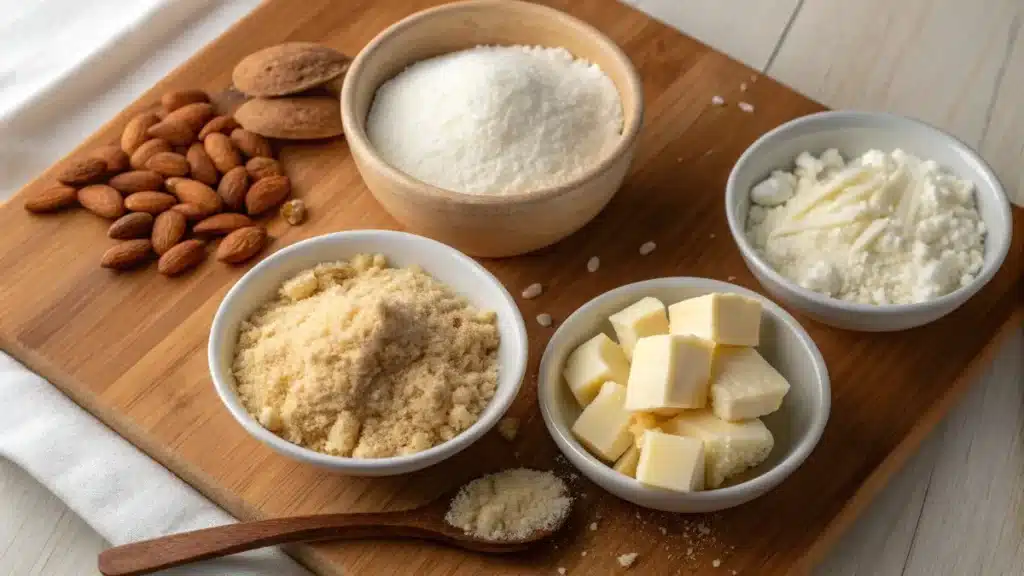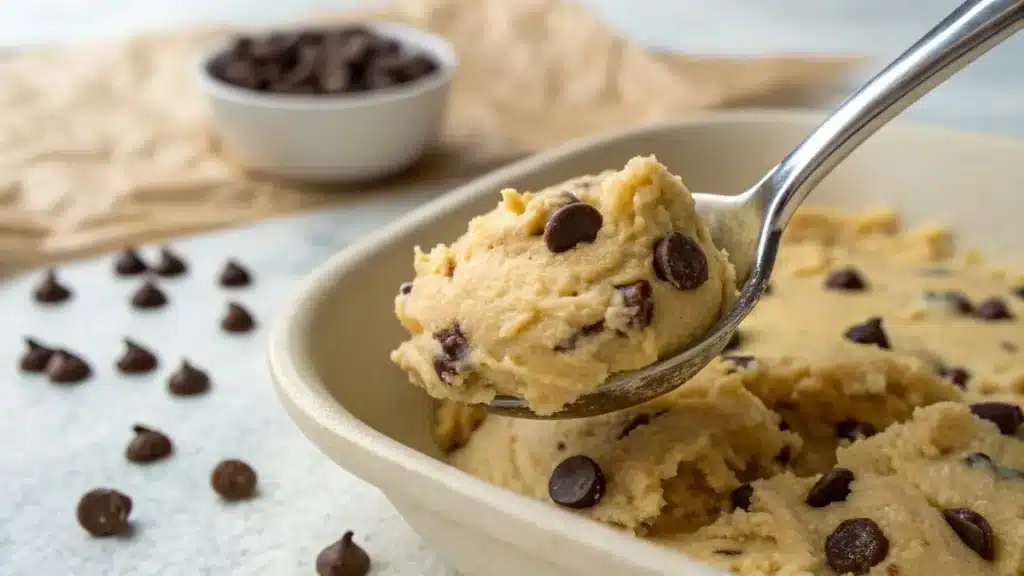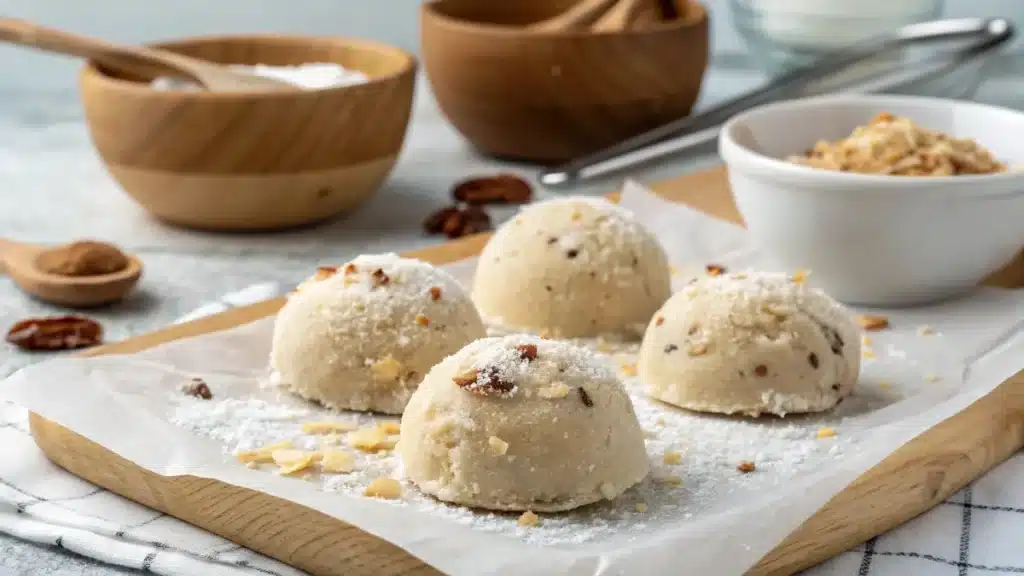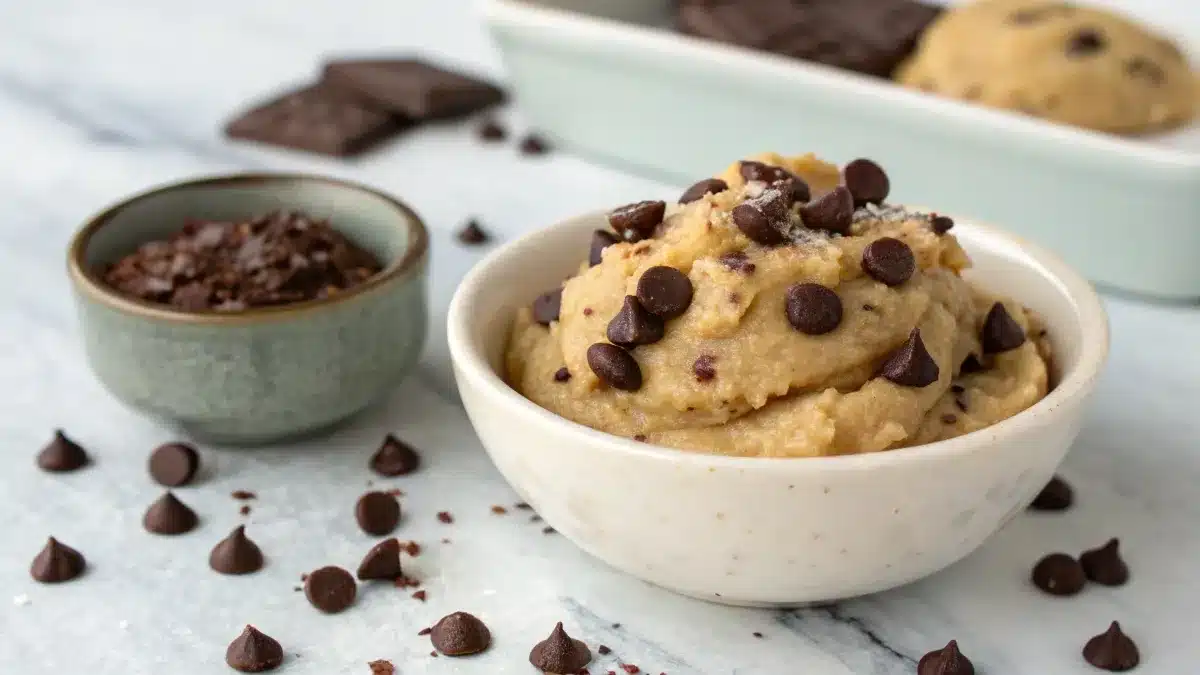Keto Edible Cookie Dough – The Best Guilt-Free Treat You’ll Love
Looking for a sweet treat that won’t knock you out of ketosis? Say hello to keto edible cookie dough — a low-carb, high-fat dessert that satisfies your cookie cravings without the sugar spike. This article walks you through everything you need to know about this delightful keto-friendly snack. From what it is and why it’s better for you, to how to make it at home, thicken it if it’s too runny, or store it safely, we’ve got you covered. You’ll also learn creative twists to make this dessert your own. Don’t miss our guide on keto dark chocolate chips to pair perfectly with your cookie dough.
Table of Contents
What is Keto Edible Cookie Dough?
Understanding the concept of keto edible cookie dough
Keto edible cookie dough is a no-bake dessert designed for people following a ketogenic or low-carb lifestyle. Unlike traditional cookie dough, which is loaded with sugar and flour, this version is made with keto-approved ingredients like almond flour, coconut flour, sugar substitutes (such as erythritol or monk fruit sweetener), and healthy fats like butter or coconut oil. Because it’s safe to eat raw and doesn’t contain eggs or untreated flour, it makes a guilt-free snack that keeps you on track with your macros.
Keto edible cookie dough isn’t just for those on a strict keto diet. It appeals to anyone wanting to cut down on sugar while still enjoying a rich, buttery, and satisfying cookie flavor. The key is using ingredients that provide the texture and taste you love while keeping carbs low and fat content high.
How keto cookie dough differs from traditional edible cookie dough
The main differences between keto edible cookie dough and the classic version lie in the ingredients. Traditional edible cookie dough often relies on all-purpose flour, brown sugar, and granulated sugar for structure and sweetness. Unfortunately, these ingredients are high in carbohydrates and can spike blood sugar levels.
Keto edible cookie dough, on the other hand, swaps out those high-carb components for alternatives that deliver the same delicious flavor with fewer carbs. Almond flour and coconut flour replace wheat flour, while sweeteners like stevia or monk fruit mimic the sweetness without the carbs. Plus, keto cookie dough usually packs more healthy fats, which help keep you full longer and support ketosis.
If you’re curious about sweet keto treats beyond cookie dough, check out this chocolate chip cookie keto candy bar that’s just as easy to whip up.
Health Benefits of Keto Edible Cookie Dough
Low-carb, high-fat profile: What it means for your body
One of the standout features of keto edible cookie dough is its ideal macronutrient balance for those on a ketogenic diet. Traditional cookie doughs are loaded with carbs, but this keto version flips that script. With low net carbs—thanks to almond flour, coconut flour, and sugar substitutes—and a rich dose of healthy fats from butter, coconut oil, or nut butters, this dessert supports ketosis. Staying in ketosis helps your body shift from burning glucose to burning fat for energy, which can aid in weight management, mental clarity, and sustained energy levels.
Additionally, the high-fat content keeps you fuller for longer. That means you’re less likely to overeat or reach for other carb-heavy snacks. You’re not just satisfying a sweet craving—you’re giving your body fuel that aligns with your keto goals.
Why keto edible cookie dough is a better snack option
Compared to conventional cookie dough and sugar-packed snacks, keto edible cookie dough offers a smarter way to indulge. First, it won’t spike your blood sugar. This is crucial for preventing the energy crashes that often follow high-carb treats. The use of natural, keto-approved sweeteners like erythritol or monk fruit means you can enjoy sweetness without the metabolic consequences.
Second, keto cookie dough is gluten-free by nature when made with almond or coconut flour, making it friendly for those with gluten sensitivities or celiac disease. Plus, because it’s egg-free and uses heat-treated flours, it’s safe to eat raw—no baking required. Looking for inspiration? Try these keto dark chocolate chips as a mix-in to boost the flavor without breaking your carb bank.
Lastly, keto edible cookie dough can be customized with add-ins like chia seeds, flax meal, or protein powders, enhancing its nutritional value even further. This snack is both incredibly tasty and endlessly adaptable. as it is delicious.
How to Make Keto Edible Cookie Dough at Home

Essential ingredients for keto edible cookie dough
Crafting the perfect keto edible cookie dough starts with the right ingredients that align with low-carb goals while still delivering on taste and texture. Let’s break down the essentials:
| Ingredient | Purpose | Keto Benefit |
|---|---|---|
| Almond flour | Base flour alternative | Low in carbs, high in healthy fats |
| Coconut flour (optional) | Adds texture, absorbs moisture | Extra fiber, low carb |
| Butter or coconut oil | Adds richness | High in healthy fats |
| Cream cheese (optional) | Provides creaminess | Adds fat and protein |
| Keto-friendly sweeteners (erythritol, monk fruit, stevia) | Sweetness without sugar | No impact on blood sugar levels |
| Vanilla extract | Enhances flavor | Zero carbs |
| Keto chocolate chips | Chocolatey goodness | Sugar-free, low carb |
| Pinch of salt | Balances sweetness | No carbs |
These ingredients work together to create a dough that’s safe to eat raw and satisfies your sweet tooth without the carbs. Want a deeper look into sugar-free chocolate options? Discover great ideas like these keto dark chocolate chips.
Step-by-step guide to creating the perfect batch
Making keto edible cookie dough is quick and easy. Follow these simple steps:
- Gather your ingredients: Ensure your butter (or coconut oil) is softened, and have all other components ready.
- Mix the fats and sweeteners: In a bowl, cream together softened butter (or coconut oil) with your choice of keto sweetener until smooth and fluffy.
- Add flavorings: Stir in vanilla extract and, if using, a touch of cream cheese for extra creaminess.
- Incorporate dry ingredients: Slowly fold in almond flour (and coconut flour if desired) until well combined. Adjust quantities to get the texture you like—start small, then add more if needed.
- Mix in keto-friendly chocolate chips or your favorite add-ins by gently folding them into the batter.
- Taste and adjust: Give it a taste—add more sweetener or salt if you like.
- Chill if desired: While it’s ready to eat, chilling for 10–15 minutes can help firm up the texture.
Looking for another fun keto dessert idea? Check out this chocolate chip cookie keto candy bar for a baked alternative that stays low carb.
Tips for Perfect Keto Edible Cookie Dough Texture
How do you make edible cookie dough not sticky?
Sticky keto edible cookie dough is often the result of too much moisture or not enough flour. Here’s how to fix it:
- Add more almond flour or coconut flour gradually. These flours absorb excess moisture and help create a firmer, less sticky texture. Since coconut flour is highly absorbent, a little goes a long way.
- Chill the dough. Letting your dough rest in the fridge for 10–20 minutes can solidify the fats (like butter or coconut oil), making the dough easier to handle.
- Use cream cheese or nut butter wisely. While they add flavor and richness, too much can increase stickiness. Adjust the amount for better consistency.
Discover great ideas like this keto dark chocolate chip guide to enhance your cookie dough without adding moisture.

Why is my edible cookie dough runny & how to fix it?
Runny cookie dough can be frustrating, but it’s easy to fix with a few tweaks:
- Check your fat-to-flour ratio. Too much melted butter or coconut oil will make your dough loose. Ensure your butter is softened, not melted, before mixing.
- Balance with additional dry ingredients. Add more almond flour, coconut flour, or even a spoonful of flaxseed meal or chia seeds. These not only thicken but also boost fiber.
- Chill before serving. Just like with sticky dough, refrigerating helps firm everything up. Ten to 30 minutes is usually enough.
Looking for inspiration? Try adding mix-ins like these keto candy bar chunks for extra structure and deliciousness.
How to Thicken and Adjust Keto Edible Cookie Dough
How do you thicken edible cookie dough the keto way?
If your keto edible cookie dough turns out too thin or soft, don’t worry—you can thicken it without adding unwanted carbs. Here’s how:
- Gradually add more almond flour. Almond flour is low in carbs and helps absorb excess moisture while maintaining a nutty, rich flavor. Start with a tablespoon at a time.
- Sprinkle in coconut flour sparingly. Coconut flour is ultra-absorbent. Just a teaspoon or two can make a significant difference without altering the taste much.
- Add protein powder. A plain or vanilla keto-friendly protein powder thickens the dough and gives it a nutritional boost.
- Use chia seeds or flaxseed meal. These absorb liquid and provide fiber, helping to firm up the dough while adding nutritional value.
These easy tweaks ensure your keto cookie dough stays creamy yet scoopable. Don’t miss our keto dark chocolate chip ideas for mix-ins that won’t affect the thickness.
Substitute options to improve texture without carbs
If you want to play around with ingredients for a better texture without adding carbs, try:
- Psyllium husk powder: Adds bulk and fiber with minimal carbs. Just a pinch can help firm things up.
- Cacao nibs or unsweetened shredded coconut: Add crunch and texture without extra carbs or sugar.
- Powdered sweetener instead of granular: If your dough feels gritty, switching to powdered erythritol or monk fruit can smooth it out.
Each adjustment helps create a satisfying, low-carb edible cookie dough that hits the right consistency while supporting your keto goals. Looking for inspiration? Check out these chocolate chip keto candy bars for texture ideas that translate to cookie dough too.
Storage and Shelf Life of Keto Edible Cookie Dough
How long can edible cookie dough be out?
Unlike traditional cookie dough, keto edible cookie dough is often made without raw eggs or untreated flour, making it a bit safer at room temperature. However, since it contains perishable ingredients like butter, cream cheese, or coconut oil, it’s best not to leave it out for more than two hours at room temperature. Beyond that, the risk of spoilage or bacterial growth increases, especially if your kitchen is warm.
If you plan to serve it at a party or gathering, consider portioning it into small bowls and keeping the rest chilled. This way, you can replenish the serving dish as needed while keeping the main batch safe and fresh.
Best practices for storing keto edible cookie dough
To maximize freshness and maintain the ideal texture of your keto edible cookie dough, here’s how to store it:
- Refrigerate: Transfer the dough into an airtight container and store it in the fridge. It will keep well for up to 5–7 days. The dough may firm up over time, so let it sit at room temperature for 5–10 minutes before scooping or eating.
- To store the dough long-term, scoop it into portions and freeze on a parchment-lined baking sheet. After it’s solid, move the portions to an airtight container or zip-top bag. This method lets you grab a ready-to-eat portion anytime. It will last up to 3 months in the freezer.
- Avoid exposure to air: Exposure to air can dry out the dough or cause off-flavors. Keep it tightly sealed for the best taste and texture.
Discover great ideas like these keto dark chocolate chips that freeze well with your dough for grab-and-go keto treats!
Safety Tips When Making Edible Cookie Dough
What happens if you don’t heat treat flour in edible cookie dough?
Traditional cookie dough recipes often call for raw all-purpose flour, which can harbor harmful bacteria like E. coli. That’s why heat-treating flour is a common food safety step. The good news? Keto edible cookie dough usually uses almond flour or coconut flour—neither of which requires heat treatment to be safe for raw consumption. These flours are typically processed in ways that reduce microbial risk. However, if you’re using any specialty flour or nut meal you’re unsure about, lightly toasting it in the oven for 5–10 minutes at 300°F can give peace of mind.
Skipping heat treatment in conventional flour can increase the risk of foodborne illness. But with keto-friendly flours, you’re generally in the clear.
What happens if you eat too much edible cookie dough?
While keto edible cookie dough is low in carbs, moderation is still key. Eating too much at once could lead to:
- Digestive note: Sugar alcohols such as erythritol or xylitol—often used in keto recipes—may lead to bloating or gas if eaten in excess.
- Calorie overload: Even without carbs, keto cookie dough is calorie-dense thanks to its high fat content. Overeating could slow your progress toward health or weight goals.
- Nutrient imbalance: Filling up on cookie dough means you might skip more nutrient-dense meals or snacks.
The best approach? Enjoy small portions as part of a balanced keto diet. Don’t miss our keto chocolate chip candy bar ideas if you’re looking for variety in your keto treats!

Creative Variations of Keto Edible Cookie Dough
Adding keto-friendly mix-ins and flavors
One of the best parts of making keto edible cookie dough is how easily you can customize it to match your cravings or dietary needs. Here are some delicious low-carb mix-ins and flavors that add variety without knocking you out of ketosis:
- Keto dark chocolate chips: A classic addition that provides rich chocolate flavor without the sugar. Discover great ideas like these keto dark chocolate chips that blend perfectly into your dough.
- Unsweetened shredded coconut: Adds a chewy texture and subtle tropical note.
- Chopped nuts (pecans, walnuts, almonds): These provide crunch and healthy fats.
- Chia seeds or flaxseed meal: Boosts fiber content and creates extra body in the dough.
- Cacao nibs: For those who love intense chocolate flavor with a bit of crunch.
- Peanut butter or almond butter swirl: Swirl it into the dough for a nutty, creamy boost.
- Cinnamon or pumpkin pie spice: A sprinkle of these spices can turn your cookie dough into a seasonal favorite.
The key is to choose mix-ins that are naturally low in carbs and complement the dough’s creamy, buttery texture.
Transforming keto cookie dough into other desserts
Your keto edible cookie dough doesn’t have to stay as dough! Here are creative ways to transform it into new treats:
- Keto cookie dough fat bombs: Roll small scoops into balls and chill or freeze. These make perfect grab-and-go snacks.
- Keto cookie dough ice cream topper: Crumble chilled dough over your favorite keto-friendly ice cream for an indulgent, low-carb sundae.
- No-bake cookie dough bars: Press the dough into a lined baking dish, top with melted keto chocolate, and chill until firm. Slice into bars for easy snacking.
- Keto truffles: Coat chilled cookie dough balls in melted sugar-free chocolate for a truffle-style dessert.
For more inspiration, check out these chocolate chip cookie keto candy bars that show how cookie dough can go from bowl to bar with minimal effort!
Conclusion
In the world of low-carb treats, keto edible cookie dough truly shines as a guilt-free indulgence that’s easy to make, customizable, and packed with healthy fats. Whether you’re craving something sweet at the end of the day or looking for a snack that keeps you full and satisfied, this dough ticks all the boxes. From understanding the unique ingredients that make it keto-friendly to mastering tips for perfect texture, thickening tricks, safe storage, and creative variations, you’re now ready to whip up a batch that suits your taste and goals.
Remember, the key is to use quality, keto-approved ingredients like almond flour, coconut flour, and sugar-free chocolate chips. And while it’s tempting to enjoy large scoops, moderation ensures you reap all the benefits without going overboard on calories. Don’t miss our guide to keto dark chocolate chips and chocolate chip keto candy bars for even more low-carb dessert inspiration.
FAQs
What happens if you don’t heat treat flour in edible cookie dough?
If you’re using traditional flour in edible cookie dough and skip heat treatment, you risk exposure to harmful bacteria such as E. coli, which can cause foodborne illness. Fortunately, keto edible cookie dough typically uses almond flour or coconut flour, both of which are generally safe to consume raw because of how they’re processed. Still, if you’re concerned, lightly toast your flour at 300°F for 5–10 minutes for extra safety.
How long can edible cookie dough be out?
Keto edible cookie dough should not be left out for more than two hours at room temperature, especially if it contains butter, cream cheese, or coconut oil. These ingredients can spoil or become unsafe if left unrefrigerated for too long. For best quality and safety, store your dough in the fridge and only take out what you’re about to eat.
How do you make edible cookie dough not sticky?
Sticky dough is usually the result of too much moisture or not enough dry ingredients. To fix it, gradually add more almond flour or coconut flour to absorb the excess moisture. You can also chill the dough for 10–20 minutes to firm up the fats. Need mix-in inspiration? Check out these keto dark chocolate chips that blend in perfectly without adding moisture.
Why is my edible cookie dough runny?
Runny dough often happens when too much butter, coconut oil, or other fat is used, or if those fats were melted rather than softened. To fix it, add more almond flour, coconut flour, or chia seeds to absorb the moisture. A quick chill in the fridge will also help firm it up.
How do you thicken edible cookie dough?
To thicken keto edible cookie dough, you can add:
More almond flour (1 tablespoon at a time)
A teaspoon of coconut flour
A spoonful of chia seeds or flaxseed meal
A small amount of keto protein powder
Each of these options will help achieve that perfect scoopable consistency without adding carbs.
What happens if you eat too much edible cookie dough?
While keto edible cookie dough is low-carb, it’s still calorie-dense because of the high fat content. Eating too much can:
Lead to digestive discomfort (especially if the dough contains sugar alcohols like erythritol or xylitol)
Contribute to consuming more calories than intended, which may slow weight loss
Crowd out more nutrient-dense keto foods
Portion control is key! Enjoy small servings and savor the rich, satisfying flavor.

